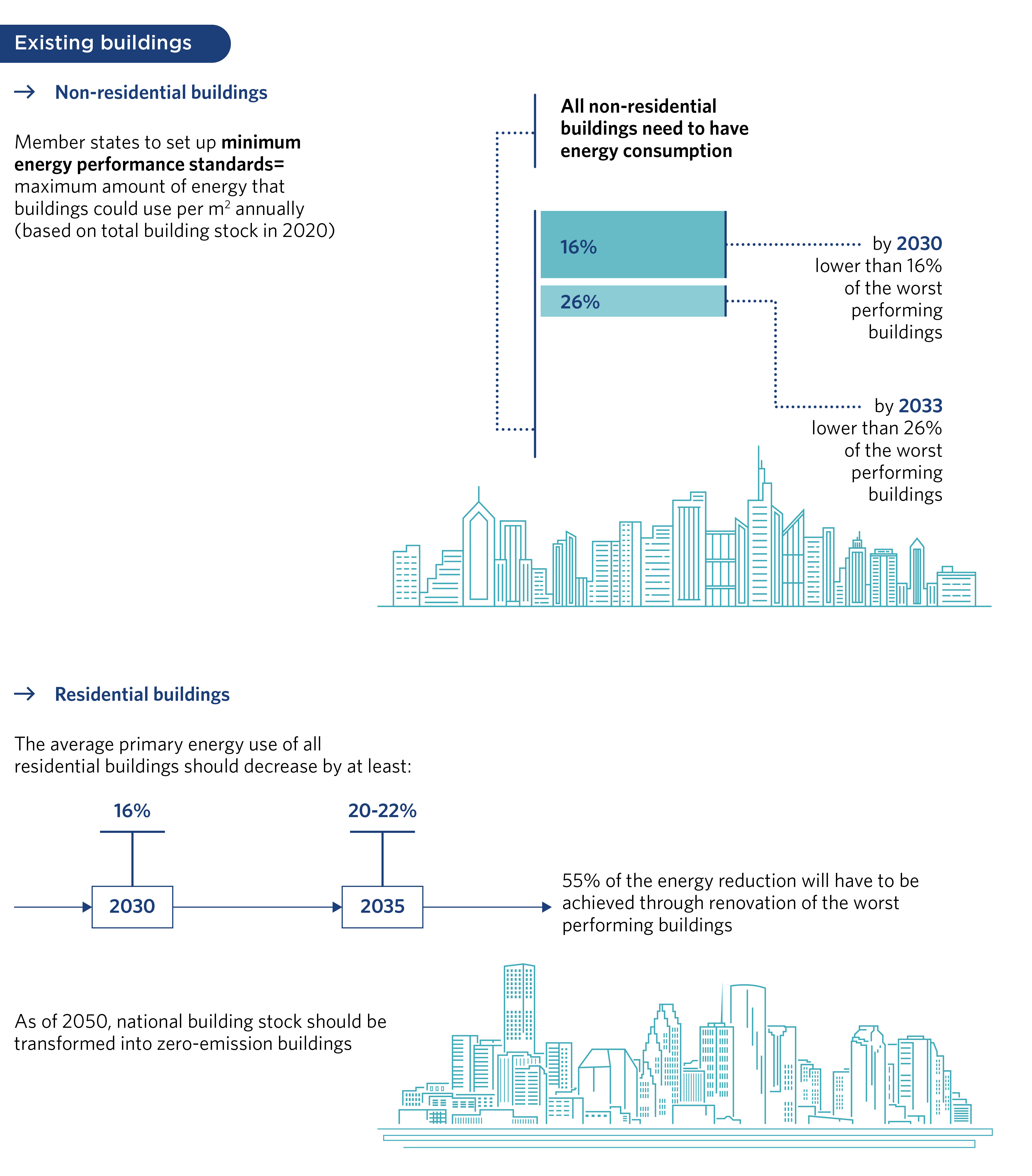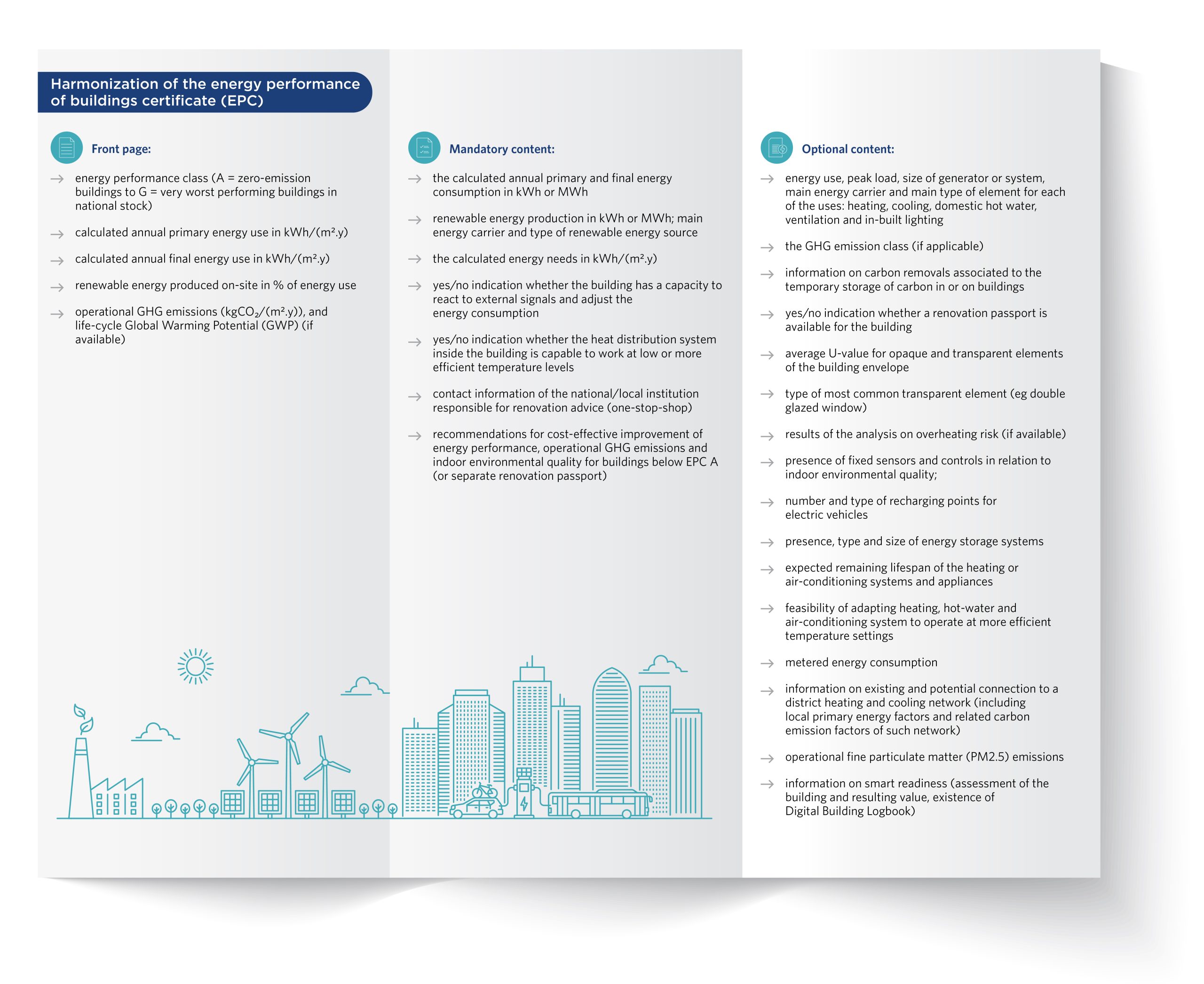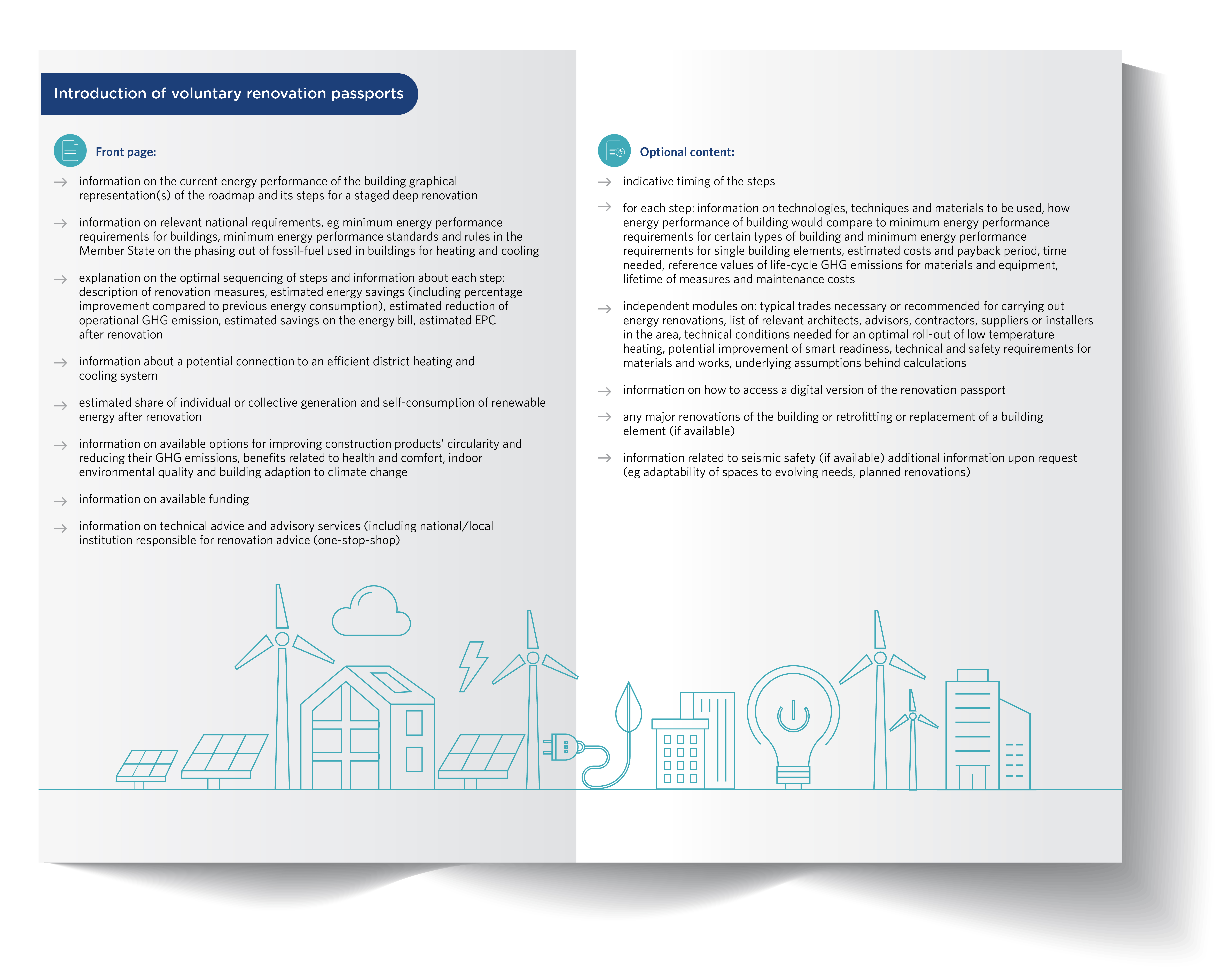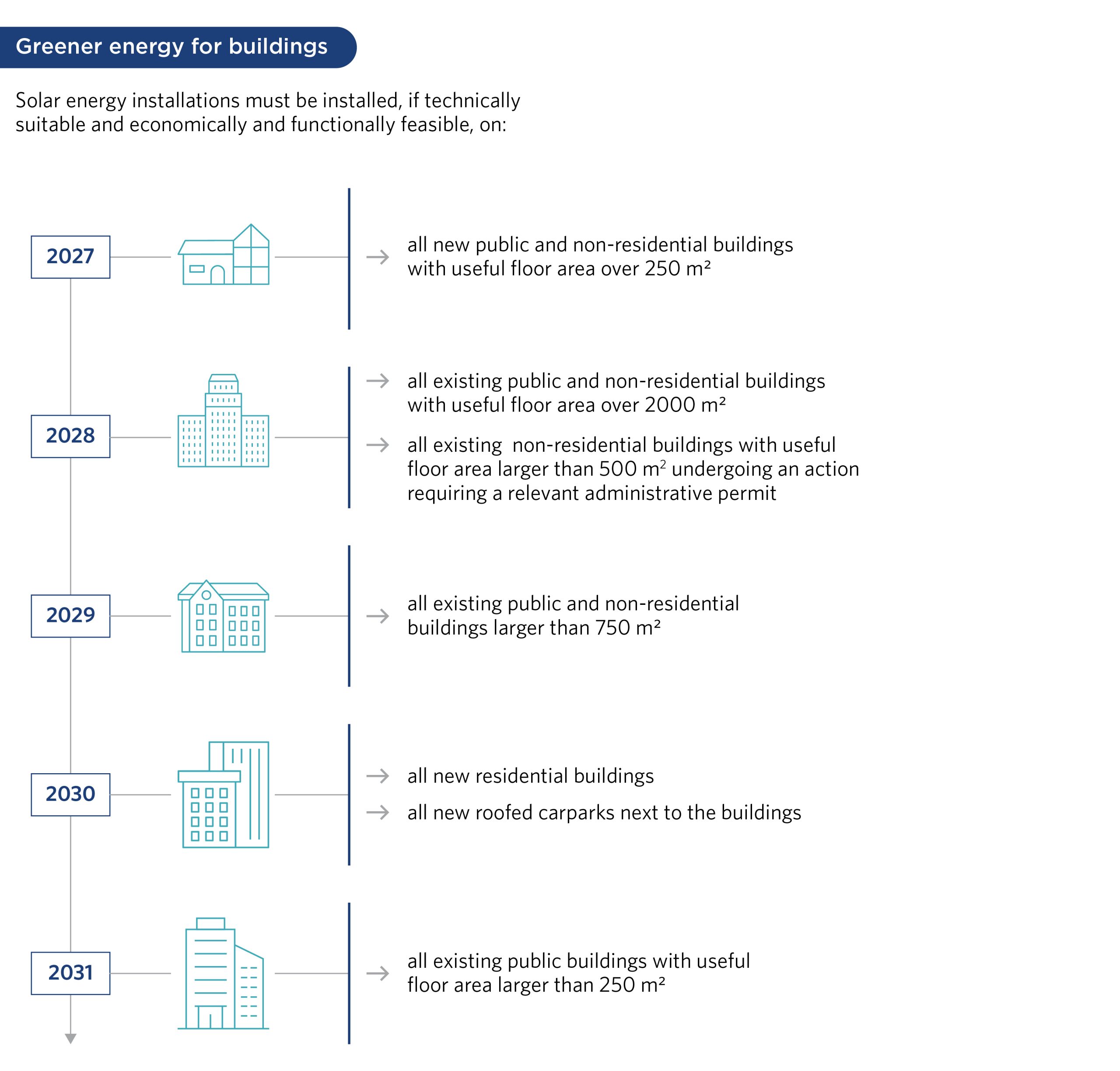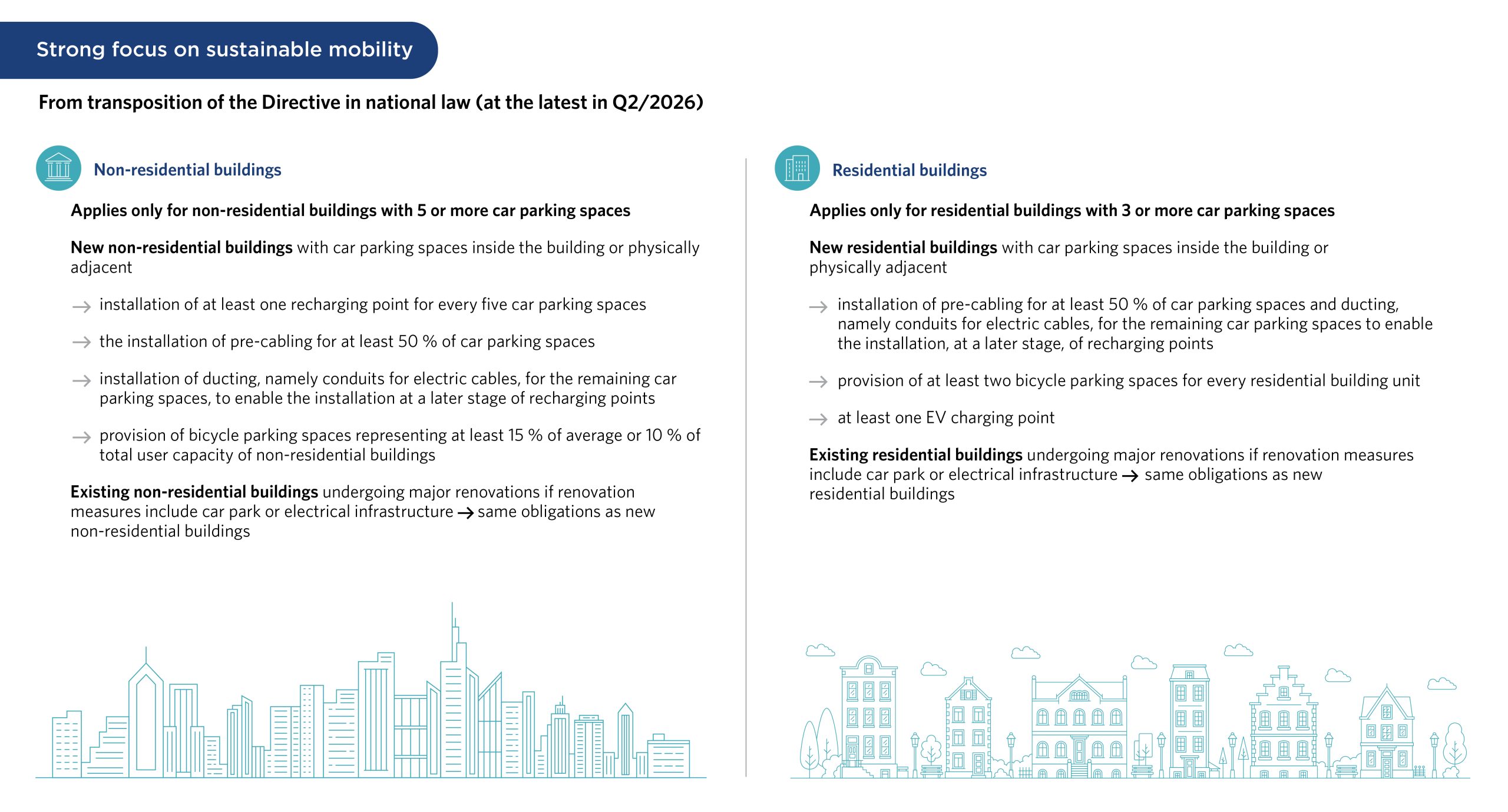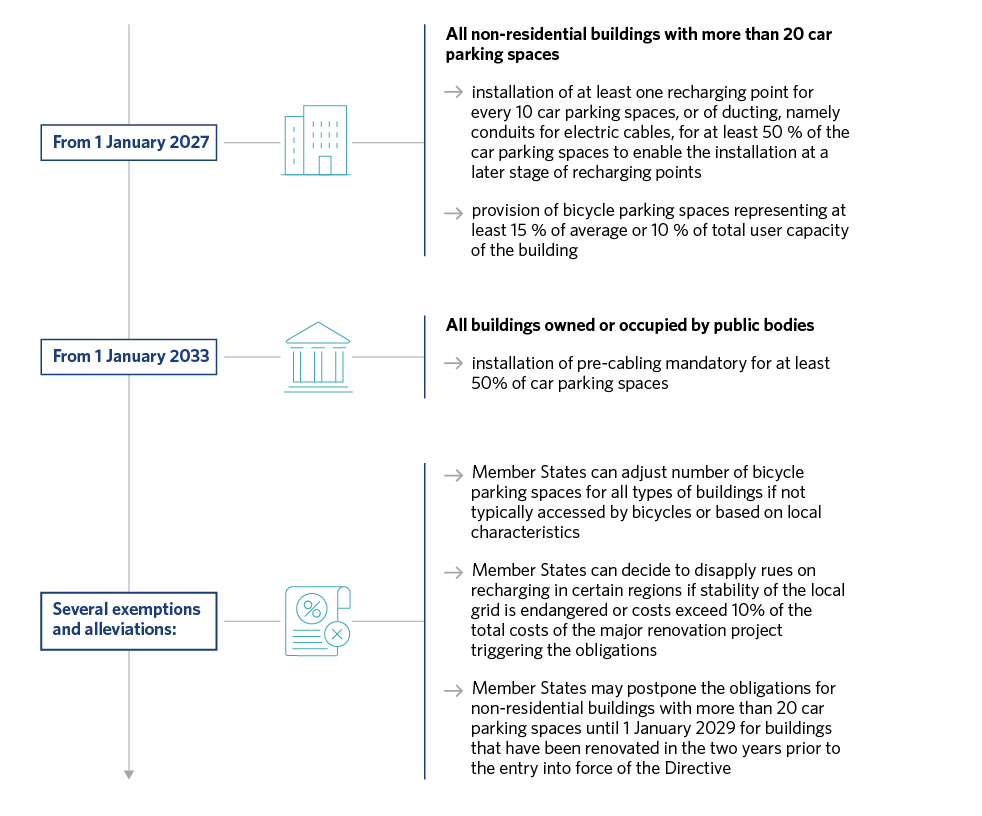In mid-March, the European Parliament adopted the recast of the Energy Performance of Buildings Directive aiming to reduce energy consumption and greenhouse gas emissions, to foster renewable energy on-site and sustainable mobility and to create harmonized standards to measure energy consumption and support renovations. The Directive is core part of the European Green Deal, contributing to the European Union's climate neutrality by 2050. In a short Q&A enhanced by graphics we explain the main elements of the Directive.
-
What is the objective of the Directive?
On March 12, 2024, European Parliament adopted a recast of the Energy Performance of Buildings Directive (Directive). The aim of the Directive is to reduce greenhouse gas (GHG) emissions and energy consumption in the European Union's building sector by introducing inter alia harmonized renovation targets, more stringent rules on energy performance certificates (EPCs) and voluntary renovation passports and promoting renewable energy, sustainable mobility and smart buildings. These measures will need to be embedded in the Member States' national building renovation plans which must also include financial incentives and advisory support to building owners and users. The Directive is a core part of the European Green Deal and the European Union's goal of climate neutrality by 2050.
-
What is the background of the Directive?
Dating from 2010 and last revised in 2018, the current version of the Directive (Directive 2010/31/EU) was clearly no longer suited to meet European Union's ambitious climate goals. Buildings account for 40% of final energy consumption in the European Union and for 36% of its energy-related GHG emissions. At the same time, 75 % of buildings in the European Union are still energy-inefficient, with heating relying heavily on natural gas (39 %), oil (11 %) and coal (3 %). Hence the need for accelerated decarbonisation was apparent. Nevertheless, it has taken more than two years of intense negotiations and public discussions to agree on a final text of the Directive acceptable to all Member States. This process is clearly reflected in the Directive which attempts to draw a fine balance between Member State autonomy and specificities of national building stock and decarbonisation targets. All of this seems to need a lot of explanatory context, since the Directive's introductory remarks make up more than a quarter of the Directive's text.
-
What is the standard for new buildings?
The current standard for new buildings, "nearly zero energy buildings" (NZEB) (see below), will be replaced by "zero-emission building" (ZEB) by 2030. A ZEB is a building meeting the following criteria:
- Very high energy performance;
- Requiring zero or a very low amount of energy;
- Producing zero on-site carbon emissions from fossil fuels; and
- Producing zero or a very low amount of operational GHG emissions.
Except for zero on-site fossil fuel carbon emissions, room is left to the Member States to define what "very high" or "very low" means for a ZEB. The Directive only stipulates that "very high energy performance" means an energy demand which is at least 10% lower than that of an NZEB. Since NZEB requirements are also set by national law, this will not necessarily lead to more harmonization at European Union level.
Source Council of the European Union
© European Union, 2023
In comparison, a "nearly zero-energy building" (NZEB) is a building meeting the following criteria:
- Very high energy performance;
- Requiring nearly zero or very low amount of energy; and
- Energy required covered to a very significant extent by energy from renewable sources, including energy from renewable sources produced on-site or nearby.
-
What are the new minimum energy performance requirements for buildings?
The Directive requires Member States to include minimum energy performance requirements in their national building renovation plans. While the Directive sets out some general principles, Member States will need to define the related national thresholds (e.g. for a building to qualify as ZEB, see above) and the national trajectory for the renovation of the building stock with the target of achieving ZEB status for the entire national building stock by 2050.
New buildings must qualify as NZEB according to the respective national thresholds as of 2026 when the Directive is transposed into national law. From 2028 (buildings owned by public bodies) and 2030 (all other buildings) new buildings will need to qualify as ZEB (see above). For existing buildings, the Directive contains the following energy consumption reduction targets based on average primary energy use. Buildings used for specific purposes, e.g. holiday homes or churches, can be excluded. The Directive specifies that Member States shall not disproportionately exempt rental residential buildings or building units but it does not contain any provisions on who will have to bear the renovation costs (see also below).
Source Council of the European Union
© European Union, 2023
-
What are the new rules on the Energy Performance Certificate (EPC)?
The existing rules on the energy performance certificate (EPC) of buildings under the current version of the Directive are patchy at most. Member States can choose to exempt entire building categories from the EPC or to issue EPCs without assigning energy performance classes. This has proven to be a real impediment to the implementation of the EU Taxonomy framework in the real estate industry and has hindered building owners and tenants to make proper use of the EPC. Even where energy performance classes were used, these did not follow the same principles and were determined based on the national building stock. The latter is not going to change but the Directive now sets out a common approach to the calculation methodology and the categorization of buildings for EPC purposes. Details are however left to the Member States.
EPCs must be determined on the basis of either calculated or metered energy use (set as primary energy use in kWh/(m2/y)) and take into account the building typology. The Directive defines 9 building categories:
- Single-family houses;
- Apartment blocks;
- Offices;
- Educational buildings;
- Hospitals;
- Hotels and restaurants;
- Sports facilities;
- Trade buildings (wholesale and retail); and
- Other types of energy-consuming buildings.
EPCs may be issued for a maximum validity of 10 years and must be independently certified. Buildings or building units offered for sale or rent must have an EPC which needs to be provided to prospective buyers or tenants. EPCs must be issued in accordance with the template provided in the Directive as follows:
Source Herbert Smith Freehills LLP
-
What are the new rules on renovation and financial incentives?
The Directive puts a particular focus on enabling building owners to perform the necessary renovations to achieve the national energy performance targets. Member States shall create financial incentives for the required renovations and embed them into their national building renovation plan. In addition, they shall setup national or local institutions which support building owners with renovation advice and information (so-called "one-stop-shops"). The Directive also mandates the European Commission to adopt a voluntary framework which supports lenders in providing capital for energy performance renovations, in line with the European Commission's focus on enabling "transition finance", i.e. the financing of decarbonization activities.
Member States must also create a framework for so-called "renovation passports" which can be issued used by building owners on a voluntary basis (unless the Member State decides to make them mandatory). Based on the common framework set out in the Directive, the renovation passport must include the following information.
Source Herbert Smith Freehills LLP
-
How will the Directive promote renewable energy on-site?
The Directive contains detailed rules on the installation of solar energy on-site, with specific deadlines for different types of buildings:
Source Council of the European Union
© European Union, 2023
-
How will the Directive promote sustainable mobility?
The Directive also contains detailed rules on recharging facilities and bicycle parking spaces for non-residential and residential buildings. However, these will to some extent depend on local characteristics and the ability of the local grid to support recharging installations, reflecting the issues currently experienced across the European Union for new and existing buildings.
Source Herbert Smith Freehills LLP
Source Herbert Smith Freehills LLP
-
When will the Directive apply?
The Directive will enter into force on the 20th day following its publication in the European Union's Official Journal (which is likely to occur in the next weeks). Member States will then have 24 months (i.e. sometime in Q2/2026) to transpose the Directive into their respective national laws. A prohibition for Member States to provide financial incentives for fossil-fuel heating will already apply as of 1 January 2025. Since many provisions of the Directive will have to be specified by the Member States, many questions will remain unanswered until the national laws implementing the Directive have been adopted.
Key contacts
Disclaimer
The articles published on this website, current at the dates of publication set out above, are for reference purposes only. They do not constitute legal advice and should not be relied upon as such. Specific legal advice about your specific circumstances should always be sought separately before taking any action.

.2024-08-22-15-30-18.jpg)
